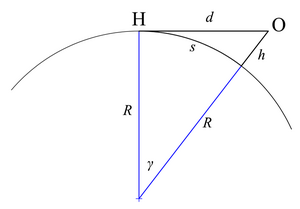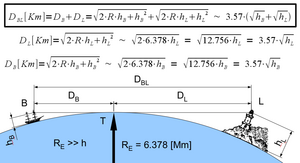
A | B | C | D | E | F | G | H | CH | I | J | K | L | M | N | O | P | Q | R | S | T | U | V | W | X | Y | Z | 0 | 1 | 2 | 3 | 4 | 5 | 6 | 7 | 8 | 9

The horizon is the apparent curve that separates the surface of a celestial body from its sky when viewed from the perspective of an observer on or near the surface of the relevant body. This curve divides all viewing directions based on whether it intersects the relevant body's surface or not.
The true horizon is a theoretical line, which can only be observed to any degree of accuracy when it lies along a relatively smooth surface such as that of Earth's oceans. At many locations, this line is obscured by terrain, and on Earth it can also be obscured by life forms such as trees and/or human constructs such as buildings. The resulting intersection of such obstructions with the sky is called the visible horizon. On Earth, when looking at a sea from a shore, the part of the sea closest to the horizon is called the offing.[1]
The true horizon surrounds the observer and it is typically assumed to be a circle, drawn on the surface of a perfectly spherical model of the relevant celestial body, i.e., a small circle of the local osculating sphere. With respect to Earth, the center of the true horizon is below the observer and below sea level. Its radius or horizontal distance from the observer varies slightly from day to day due to atmospheric refraction, which is greatly affected by weather conditions. Also, the higher the observer's eyes are from sea level, the farther away the horizon is from the observer. For instance, in standard atmospheric conditions, for an observer with eye level above sea level by 1.70 metres (5 ft 7 in), the horizon is at a distance of about 4.7 kilometres (2.9 mi).[2] When observed from very high standpoints, such as a space station, the horizon is much farther away and it encompasses a much larger area of Earth's surface. In this case, the horizon would no longer be a perfect circle, not even a plane curve such as an ellipse, especially when the observer is above the equator, as the Earth's surface can be better modeled as an oblate ellipsoid than as a sphere.
Etymology
The word horizon derives from the Greek ὁρίζων κύκλος (horízōn kýklos) 'separating circle',[3] where ὁρίζων is from the verb ὁρίζω (horízō) 'to divide, to separate',[4] which in turn derives from ὅρος (hóros) 'boundary, landmark'.[5]
Appearance and usage

Historically, the distance to the visible horizon has long been vital to survival and successful navigation, especially at sea, because it determined an observer's maximum range of vision and thus of communication, with all the obvious consequences for safety and the transmission of information that this range implied. This importance lessened with the development of the radio and the telegraph, but even today, when flying an aircraft under visual flight rules, a technique called attitude flying is used to control the aircraft, where the pilot uses the visual relationship between the aircraft's nose and the horizon to control the aircraft. Pilots can also retain their spatial orientation by referring to the horizon.
In many contexts, especially perspective drawing, the curvature of the Earth is disregarded and the horizon is considered the theoretical line to which points on any horizontal plane converge (when projected onto the picture plane) as their distance from the observer increases. For observers near sea level, the difference between this geometrical horizon (which assumes a perfectly flat, infinite ground plane) and the true horizon (which assumes a spherical Earth surface) is imperceptible to the unaided eye. However, for someone on a 1,000 m (3,300 ft) hill looking out across the sea, the true horizon will be about a degree below a horizontal line.
In astronomy, the horizon is the horizontal plane through the eyes of the observer. It is the fundamental plane of the horizontal coordinate system, the locus of points that have an altitude of zero degrees. While similar in ways to the geometrical horizon, in this context a horizon may be considered to be a plane in space, rather than a line on a picture plane.
Distance to the horizon
Ignoring the effect of atmospheric refraction, distance to the true horizon from an observer close to the Earth's surface is about[2]
where h is height above sea level and R is the Earth radius.
The expression can be simplified as:
where the constant equals k=3.57 km/m½=1.22 mi/ft½. In this equation, Earth's surface is assumed to be perfectly spherical, with R equal to about 6,371 kilometres (3,959 mi).
Examples
Assuming no atmospheric refraction and a spherical Earth with radius R=6,371 kilometres (3,959 mi):
- For an observer standing on the ground with h = 1.70 metres (5 ft 7 in), the horizon is at a distance of 4.7 kilometres (2.9 mi).
- For an observer standing on the ground with h = 2 metres (6 ft 7 in), the horizon is at a distance of 5 kilometres (3.1 mi).
- For an observer standing on a hill or tower 30 metres (98 ft) above sea level, the horizon is at a distance of 19.6 kilometres (12.2 mi).
- For an observer standing on a hill or tower 100 metres (330 ft) above sea level, the horizon is at a distance of 36 kilometres (22 mi).
- For an observer standing on the roof of the Burj Khalifa, 828 metres (2,717 ft) from ground, and about 834 metres (2,736 ft) above sea level, the horizon is at a distance of 103 kilometres (64 mi).
- For an observer atop Mount Everest (8,848 metres (29,029 ft) in altitude), the horizon is at a distance of 336 kilometres (209 mi).
- For an observer aboard a commercial passenger plane flying at a typical altitude of 35,000 feet (11,000 m), the horizon is at a distance of 369 kilometres (229 mi).
- For a U-2 pilot, whilst flying at its service ceiling 21,000 metres (69,000 ft), the horizon is at a distance of 517 kilometres (321 mi).
Other planets
On terrestrial planets and other solid celestial bodies with negligible atmospheric effects, the distance to the horizon for a "standard observer" varies as the square root of the planet's radius. Thus, the horizon on Mercury is 62% as far away from the observer as it is on Earth, on Mars the figure is 73%, on the Moon the figure is 52%, on Mimas the figure is 18%, and so on.
Derivation



If the Earth is assumed to be a featureless sphere (rather than an oblate spheroid) with no atmospheric refraction, then the distance to the horizon can easily be calculated.[6]
The tangent-secant theorem states that
Make the following substitutions:
- d = OC = distance to the horizon
- D = AB = diameter of the Earth
- h = OB = height of the observer above sea level
- D+h = OA = diameter of the Earth plus height of the observer above sea level,
with d, D, and h all measured in the same units. The formula now becomes
or
where R is the radius of the Earth.
The same equation can also be derived using the Pythagorean theorem. At the horizon, the line of sight is a tangent to the Earth and is also perpendicular to Earth's radius. This sets up a right triangle, with the sum of the radius and the height as the hypotenuse. With
- d = distance to the horizon
- h = height of the observer above sea level
- R = radius of the Earth
referring to the second figure at the right leads to the following:
The exact formula above can be expanded as:
where R is the radius of the Earth (R and h must be in the same units). For example, if a satellite is at a height of 2000 km, the distance to the horizon is 5,430 kilometres (3,370 mi); neglecting the second term in parentheses would give a distance of 5,048 kilometres (3,137 mi), a 7% error.
Approximation

If the observer is close to the surface of the Earth, then it is valid to disregard h in the term (2R + h), and the formula becomes-
Using kilometres for d and R, and metres for h, and taking the radius of the Earth as 6371 km, the distance to the horizon is
- .
Using imperial units, with d and R in statute miles (as commonly used on land), and h in feet, the distance to the horizon is
- .
If d is in nautical miles, and h in feet, the constant factor is about 1.06, which is close enough to 1 that it is often ignored, giving:
These formulas may be used when h is much smaller than the radius of the Earth (6371 km or 3959 mi), including all views from any mountaintops, airplanes, or high-altitude balloons. With the constants as given, both the metric and imperial formulas are precise to within 1% (see the next section for how to obtain greater precision). If h is significant with respect to R, as with most satellites, then the approximation is no longer valid, and the exact formula is required.
Related measures
Arc distance
Another relationship involves the great-circle distance s along the arc over the curved surface of the Earth to the horizon; this is more directly comparable to the geographical distance on a map.
It can be formulated in terms of γ in radians,
then
Solving for s gives
The distance s can also be expressed in terms of the line-of-sight distance d; from the second figure at the right,
substituting for γ and rearranging gives
The distances d and s are nearly the same when the height of the object is negligible compared to the radius (that is, h ≪ R).
Zenith angle

When the observer is elevated, the horizon zenith angle can be greater than 90°. The maximum visible zenith angle occurs when the ray is tangent to Earth's surface; from triangle OCG in the figure at right,
where is the observer's height above the surface and is the angular dip of the horizon. It is related to the horizon zenith angle by:
For a non-negative height , the angle is always ≥ 90°.
Objects above the horizon

To compute the greatest distance DBL at which an observer B can see the top of an object L above the horizon, simply add the distances to the horizon from each of the two points:
- DBL = DB + DL
For example, for an observer B with a height of hB=1.70 m standing on the ground, the horizon is DB=4.65 km away. For a tower with a height of hL=100 m, the horizon distance is DL=35.7 km. Thus an observer on a beach can see the top of the tower as long as it is not more than DBL=40.35 km away. Conversely, if an observer on a boat (hB=1.7 m) can just see the tops of trees on a nearby shore (hL=10 m), the trees are probably about DBL=16 km away.
Referring to the figure at the right, and using the approximation above, the top of the lighthouse will be visible to a lookout in a crow's nest at the top of a mast of the boat if
Antropológia
Aplikované vedy
Bibliometria
Dejiny vedy
Encyklopédie
Filozofia vedy
Forenzné vedy
Humanitné vedy
Knižničná veda
Kryogenika
Kryptológia
Kulturológia
Literárna veda
Medzidisciplinárne oblasti
Metódy kvantitatívnej analýzy
Metavedy
Metodika
Text je dostupný za podmienok Creative
Commons Attribution/Share-Alike License 3.0 Unported; prípadne za ďalších
podmienok.
Podrobnejšie informácie nájdete na stránke Podmienky
použitia.
www.astronomia.sk | www.biologia.sk | www.botanika.sk | www.dejiny.sk | www.economy.sk | www.elektrotechnika.sk | www.estetika.sk | www.farmakologia.sk | www.filozofia.sk | Fyzika | www.futurologia.sk | www.genetika.sk | www.chemia.sk | www.lingvistika.sk | www.politologia.sk | www.psychologia.sk | www.sexuologia.sk | www.sociologia.sk | www.veda.sk I www.zoologia.sk























